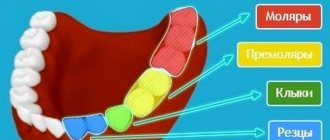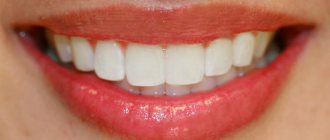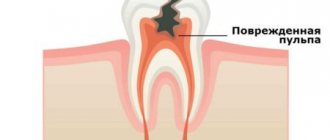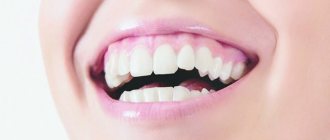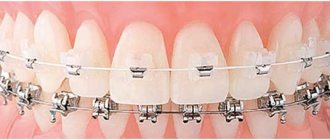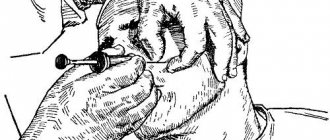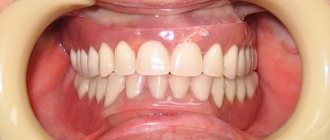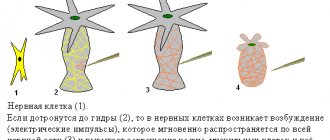Publication date: October 02, 2022.
Date the information on this page was updated: November 03, 2022.
According to research, most people have an incorrect bite. At the same time, most of them do not even know about the presence of a problem, and they come to the orthodontist only with the problem of “uneven teeth”. But malocclusion is not always accompanied by a violation of the aesthetics of the dentition. Bite or occlusion is the position of the teeth and jaws when closed. A physiological or normal bite is when the teeth in the dentition have tight contacts, the chewing surfaces of antagonist teeth (teeth on the opposite jaw) evenly close together, the upper incisors overlap the lower ones by 1/3.
Malocclusion can take two forms: dental and skeletal.
With dental form
pathological closure of the bite is formed due to the incorrect location of the teeth, their abnormal size, deficiency or supernumeration, as well as improper development of the dentoalveolar process - that part of the oral cavity from where the teeth grow. With such a bite, the patient's jaws, as a rule, have the correct physiological size and location.
If the size or position of the jaws causes improper closure of the teeth, then such a bite is called skeletal
. Skeletal abnormalities can manifest themselves in increased (macrognathia) or decreased (micrognathia) size of the jaw, in its advancement forward (prognathia) or backward (retrognathia). Skeletal malocclusion is usually more difficult to correct than dental anomalies, and in particularly severe cases it may not be possible without surgery.
Malocclusion can be a combination of skeletal and dental anomalies, and one type can also be a consequence of another: due to the incorrect position of the jaws, teeth grow crookedly, and vice versa, the incorrect position of the teeth leads to a forced position of the jaws and the bite is fixed in a skeletal shape.
How is the bite formed?
The process of bite formation is long - from birth to adolescence. There are 5 periods.
- Initial (up to 6 months): no teeth, the upper jaw is larger in size than the lower jaw. At this time, an active feeding process is extremely important for the proper development of the jaw apparatus.
- Emerging temporary bite (6 months - 3 years): baby teeth and a bite appear, but it is still temporary. This stage is accompanied by inflammation of the gums, a rise in temperature, often grinding of teeth (bruxism), and emerging teeth may be crooked. It is important to maintain hygiene without taking any orthodontic measures.
- Formed temporary occlusion (3 - 6 years): baby teeth have erupted and can close in different ways, jaw growth continues. This is the time of active use of teeth. Characteristic wear of temporary teeth is considered normal before the upcoming change.
- Changeable dentition (6-12 years): jaw growth, loss of baby teeth and appearance of permanent teeth. Often new teeth, especially the lower ones, erupt unevenly. During this period, it is necessary to decide on a plan for further correction of the bite.
- Permanent dentition (12 - 15 years): replacement of milk teeth with permanent ones, all 28 teeth are visible, no wisdom teeth. The period is most favorable for orthodontic treatment.
In order for the bite to form correctly, there must be careful attention to teething, oral hygiene, and a timely plan to correct emerging problems.
Causes of pathological bite
The formation of occlusion is a long and complex process that begins at the stage of intrauterine development, continues in early childhood and ends after the end of puberty. Pathological occlusion is the result of long-term influence of a number of unfavorable external or internal factors at different periods of a person’s life:
- Genetic factor. A genetically determined anomaly is formed when there is a congenital discrepancy in the size of the teeth and dentofacial bones (crowding of teeth or the presence of spaces between teeth) or a hereditarily determined abnormal shape and size of the lower and upper jaws.
- The influence of negative factors on the body of a pregnant woman. The formation of the dental apparatus in the fetus can be influenced by bad habits, poor nutrition and diseases suffered by a woman during pregnancy.
- Birth injury. During childbirth, the baby may receive injuries leading to displacement of the temporomandibular joint.
- Negative factors affecting the baby’s body in the first years of life. The reason for the formation of a distal bite may be the incorrect selection of nipples or the late introduction of solid foods into the diet.
- Bad habits and behavioral factors in early childhood. The habit of sucking a pacifier or finger, or sleeping with the head thrown back can cause a child to develop a deep bite.
- Factors influencing the formation of anomalies in later life. These include carious lesions of the teeth, ENT pathologies, deviated nasal septum, and diseases of the skeletal system.
Treatment of abnormal bite should begin as early as possible. Early diagnosis and therapy make it possible to restore the normal functioning of the dentofacial apparatus more effectively. Doctors at the Consilium-Dent use specially developed diagnostic tests and tables. They are used both for direct examination of the oral cavity and for diagnosis using dental casts.
The need for a particular therapeutic measure is determined by a specialist based on the diagnostic results on an individual basis. You cannot resort to self-medication in this situation. This can lead to activation of the pathological process.
Correct teeth bite
An ideal orthognathic bite implies the presence of the following features:
- The upper dental arch is slightly inclined forward and has the shape of a semi-ellipse, the lower, in the shape of a parabola, is slightly backward.
- When the jaws close, each upper tooth contacts the opposite tooth below.
- There are no obvious gaps between the teeth.
- The upper teeth overlap the lower teeth by about a third of their height.
Despite the fact that there are the above parameters for a perfect smile, the question “What should be the bite of the teeth?” cannot be answered unambiguously. In addition to the orthognathic bite, modern orthodontics allows for several options for the normal structure of the dentition and the location of the jaws.
Orthognathic
The upper row of teeth overlaps the lower one by 30% of the height, there are no gaps between the teeth or spaces between the rows.
Biprognathic
The dentition is slightly directed towards the vestibule of the mouth.
Progenic
The lower jaw moves forward slightly.
Straight
When the jaws close, the upper teeth come into contact with the lower cutting edges.
Types of correct bite
There are only types of physiological occlusion that are close to ideal and do not require surgical or dental intervention. In the presence of normal occlusion, a person chews food well, does not feel pain in the temporomandibular joint, and rarely complains of thinning tooth enamel.
Orthognathic
Closest to the physiological norm. It is easy to determine at home: the molars are in close contact with each other, the upper incisors slightly cover the lower ones. To confirm the diagnosis, orthodontists assess the position of the dentition in the axial plane.
Straight
This type is characterized by the fact that both incisors and molars are closed. Both jaws are the same size. With direct occlusion, the smile becomes more aesthetic and attractive. But with this position of the teeth, the enamel is quickly erased, the teeth are worn down, early formation of cracks, chips, and destruction of the bone structure are observed.
Biprognathic
This variety is typical for children who had the habit of sucking their thumb or who got rid of the pacifier late. The anomaly often occurs when there is an incorrect location of the frenulum of the tongue. If, due to the latter, the organ of the oral cavity puts pressure on the front teeth, the incisors will gradually bend towards the exit from the mouth. At the same time, they will touch, so such an occlusion is considered physiological.
Opisthognathic
The main characteristic of an orthognathic bite is the correct closure of the maximum number of teeth among themselves. It is considered correct occlusion and has a subtype of opisthognathic occlusion: the position of the molars does not change, they coincide with the fissures. The difference between occlusions is that in opisthognathic occlusions the incisors of both jaws are slightly bent inward.
Malocclusion of teeth
Look at your reflection in the mirror. If you notice an excessively protruding upper or lower lip, teeth that “overlap” each other, or gaps between the dentition when the jaws are closed, this is a clear reason to consult a specialist. Descriptions of dental anomalies and photographs of teeth with malocclusion pathologies are presented in the table below.
Distal (prognathic)
In a distal bite, the upper jaw is more developed than the lower jaw.
Mesial (medial)
With a mesial bite, the lower jaw is pushed forward.
Cross
In a crossbite, the rows of teeth intersect in the manner of scissors when the jaws close.
Deep
In a deep bite, the upper teeth significantly overlap the lower teeth.
Open
The presence of pronounced gaps between the dentition when the jaws are closed indicates an open bite.
What is overbite
Bite is the relationship between the lower and upper dentitions with full closure and maximum contact. This is the first parameter that a competent orthodontist evaluates in a child or adult. Basic bite problems can be determined even by eye: the doctor just needs to ask the patient to clench his teeth.
There is a correct (normal, physiological) bite, in which the load on the teeth is uniform, and a pathological one. Malocclusion can develop at any age due to various factors. It greatly affects the body and general condition of a person.
Bite in the absence of teeth
A person without teeth has problems with the functioning of the temporomandibular joints, facial aesthetics deteriorate, and wrinkles appear due to loss of skin tone. To avoid unpleasant consequences, it is necessary to restore the bite using a complete denture made using a special technique.
Bite restoration with complete dentures
- The central ratio of the jaws is determined - the position of the lower jaw in relation to the upper in three planes: vertical, sagittal and transversal. The role of the dentition is played by wax rollers.
- Measurements are taken using a device consisting of an external facebow-ruler and an intraoral plate with a flat frontal part and curved distal parts.
- The plaster model marks the boundaries of the future structure, the line of the middle of the alveolar process, the tubercles of the upper and lower jaw, and the midline.
- Artificial teeth are placed in such a way that when you smile, the part of the prosthesis that imitates the gum is not visible.
Common types of malocclusions
The most common anomalies of the dental system include deep bite. A severe degree of pathology is characterized by a situation where the upper row of teeth completely overlaps the lower row. When the jaws are closed, the upper incisors can injure the mucous membrane of the lower gums. Therefore, this type of anomaly is called a traumatic bite.
A deep bite is accompanied by a violation of facial aesthetics, impaired diction, poor quality of chewing food, and increased abrasion of the enamel.
There are two degrees of development of pathology. They are caused by various provoking factors and are characterized by different forms of manifestation:
- Primary deep bite is often due to genetic reasons and is determined by the special structure of the facial bones. It manifests itself as pathological changes in the area of the dentition, alveolar process and basal part of the jaws. The movement of the jaws is blocked, and the patient experiences significant discomfort when chewing.
- Secondary deep bite is acquired in nature and is a consequence of a disease or injury. As a result of a decrease in the interalveolar distance and the lower third of the face, a deep traumatic closure of the incisors develops.
Another type of pathology classification is carried out depending on the nature of the interaction of the lateral teeth.
- A deep distal bite is characterized by the overlap of the lower row of teeth with the upper ones by more than one third of the length of the crown with a violation of the relationship of the lateral teeth. Characteristic disorders include difficulty biting and chewing, breathing problems, and pain in the temporomandibular joint.
- Deep neutral bite: when the overlap of the lower front teeth with the upper ones is disturbed, while the position of the lateral teeth is not disturbed.
If you experience even minor discomfort when chewing, you should immediately contact a specialist and follow his recommendations.
The presence of a malocclusion or a predisposition to it is determined by an orthodontist after an initial examination using special tests. Self-diagnosis does not provide an objective picture of the condition of the dentofacial apparatus, since different pathologies may have the same symptoms. Treatment in this case will be radically different.
If there are no problems with your bite, you should visit the orthodontist for a preventive examination approximately once every six months. The doctor will determine whether there is a tendency to a particular anomaly even before the problem is noticeable.
Bite after wisdom tooth removal
Some doctors are convinced that wisdom teeth are an atavism and must be gotten rid of. In ancient times, they were used to chew tough foods, such as raw meat. With the development of civilization, the human diet changed, his jaw began to gradually decrease - and the “eights” turned out to be superfluous. Most often, before starting to correct the bite, wisdom teeth are removed. This frees up space for the correct formation of rows, and the result of teeth alignment will be much better.
Incorrect or abnormal bite
The bite is considered incorrect when there are anomalies in the location of the teeth and occlusion disorders, as a result of which the functions of the dentofacial system are disrupted. All types of malocclusion, to a greater or lesser extent, lead to the destruction and loss of teeth, disorders of the TMJ (temporomandibular joint), as well as facial asymmetry. The consequences of an abnormal bite are discussed in more detail below. Orthodontic treatment in this case is necessary not so much for aesthetics, but for maintaining health.
What affects the bite of teeth?
The negative impact of defects in the dental system on the condition of the entire organism has been repeatedly proven by scientists. The list of identified health risks is impressive even for ardent optimists.
- Due to improper distribution of the chewing load, tooth enamel wears off faster, teeth begin to react painfully to cold and hot, their necks become exposed, and noticeable gaps form between the teeth.
- Diseases of the temporomandibular joints occur, accompanied by headaches and a characteristic clicking sound when the jaws move.
- The aesthetics of the face suffers: its proportions change, wrinkles form, teeth become crooked, and the smile becomes unattractive.
- It becomes difficult to bite food, chewing functions are disrupted, causing diseases of the gastrointestinal tract.
- Speech defects appear, facial expressions are distorted, and self-esteem decreases.
- Crowding and crooked teeth cause accelerated tooth decay due to frequent chipping and carious lesions.
- The oral mucosa is injured - cheeks, gums, tongue, and the tissues of the oral cavity become inflamed.
- The quality of breathing deteriorates, which leads to diseases of the nasopharynx, trachea, and hearing aid.
Pathologies and bite defects
An ideal correct bite is a rare phenomenon in dentistry. Much more often, patients experience various anomalies. Depending on the type of deviation, pathological types of bites can be distinguished:
- Open - the frontal and lateral dental units of the jaws do not contact when closing. A characteristic feature of the anomaly is the presence of a gap between the dentition. The jaws do not close completely, which is why the lips and mouth are always in a half-open position. Visual signs: deformation of the facial profile, drooping chin, smoothed nasolabial and chin folds. This form of pathology is dangerous due to carious lesions of teeth and increased abrasion of chewing units.
- Deep or traumatic, also known as disocclusion, is the overlap of the lower incisors with the upper ones in excess of the norm, that is, by more than a third of the height of the crowns. With disocclusion, the upper jaw protrudes forward. The pathology is easily recognized by the deformation of the shape of the face - the lower third is shortened, the lower lip turns outward. This anomaly is a very dangerous phenomenon and requires urgent correction. With a deep bite, the front teeth are overloaded, and there is an increased risk of developing stomatitis, periodontitis, gingivitis, and periodontal disease. Disocclusion causes a lot of inconvenience - difficulties in biting and chewing food, diction defects, breathing problems, headaches and aching pains.
- Distal or prognathic - the upper frontal incisors protrude above the lower ones and overlap them beyond the norm, a gap is formed between them - a sagittal fissure, the upper jaw and lip, the nose move forward. Distal pathology is reflected in posture - patients are characterized by stooping. With distal occlusion, there is discomfort when swallowing and chewing, impaired speech functions, and difficulty in nasal breathing.
- Mesial – advancement of the lower jaw forward. Most often, mesial occlusion occurs with a distal position or underdevelopment of the upper jaw and with an increased size of the chin or basal region of the lower jaw. Accompanied by the formation of diastemas, trema, dystopia, and speech defects. But the most dangerous consequences are improper distribution of the chewing load and overload of the tissues of the oral cavity, which often results in the development of periodontitis, gingivitis, caries, which ultimately leads to premature tooth loss. In addition, mesial occlusion interferes with implantation and prosthetics.
- Crossed - one or more lower teeth overlap the upper ones. It occurs in both the lateral and anterior jaw regions and is visually manifested in the displacement of the chin and facial asymmetry. Most often it occurs due to improper development of the dentofacial system, early loss of baby teeth, facial injuries and a number of other reasons. With cross-occlusion, there is increased tooth wear, excessive load on the teeth, a decrease in gingival tissue, the development of dental diseases, and temporal pain.
All abnormal types of dental bites require correction. The sooner treatment is started, the faster and easier it is to correct the problem. In addition, early treatment will avoid many consequences and diseases that develop due to abnormal occlusion.
Treatment of dental malocclusion
How to change the bite of teeth? Pathologies of the dental system can only be eliminated through orthodontic treatment. An exception is the correction of a low bite, when the height of the teeth decreases with age due to their wear. In such cases, the bite is corrected by dental prosthetics with crowns or veneers, as well as by implantation. Other anomalies of teeth and bite can be removed at any age with special orthodontic structures or through surgical intervention.
However, maxillofacial operations are performed only in case of serious deviations from the norm. Usually, to correct dental malocclusion, doctors suggest correction with braces or aligners.
Now that you know about all the health risks that can cause pathologies of the dental system, and how to correct your dental bite, all that remains is to take specific actions. Even if at first glance it seems that your teeth are straight, make an appointment with an orthodontist. Diagnosing the condition of the dentition will help maintain the health of other organs and systems. And timely orthodontic treatment will make your smile more attractive and significantly reduce the number of future visits to the dentist.
Symptoms
The specificity of the manifestations depends on the specific type of defect. At the first symptoms indicating the presence of abnormalities, it is recommended to undergo a comprehensive orthodontic diagnosis, the results of which determine the need for dental treatment. Characteristics that deserve attention include:
- Violation of the occlusion of the elements of the upper and lower row.
- Formation of spaces between teeth.
- Curved position of individual units.
- Intense accumulation of plaque and tartar.
- Complete coverage of the crown surface.
- Bleeding gums during hygienic cleaning.
- Deviation of facial symmetry.
- Speech defects, problems with breathing and posture.
- Extraneous sounds and difficulty opening the mouth.
Various types and varieties of malocclusion are characterized by the presence of common features - in all cases the patient experiences physical and psychological discomfort associated with impaired functionality and aesthetics. Muscle strain provokes increased fatigue and can also cause regular pain, manifested in the occipital and cervical region.
What factors influence malocclusion? Is there any way to avoid the problem?
Typically, the bite develops in people between infancy and about 17 years of age. It may be incorrect due to the following reasons:
- genetic predisposition;
- bad childhood habits: pacifier sucking, bottle feeding, finger sucking;
- problems with the spine that have not been corrected;
- chronic ENT diseases (for example, adenoiditis);
- calcium deficiency, as a result of which bone tissue is not formed correctly.
It is important! If a child breathes predominantly through his mouth during sleep, play, or in a calm state, this is one of the signals of problems, which may include an incorrect bite. The faster occlusion pathologies are corrected, the less likely it is that not only dental problems will occur, but also ENT diseases.
